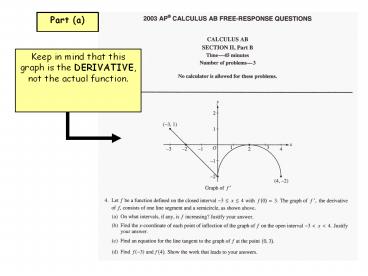Part (a) - PowerPoint PPT Presentation
Part (a)
Title: No Slide Title Author: BBHHS Last modified by: Administrator Created Date: 12/31/2003 5:32:28 PM Document presentation format: On-screen Show – PowerPoint PPT presentation
Title: Part (a)
1
Part (a)
2
When the 1st derivative is positive, the original
function is RISING.
3
(No Transcript)
4
Part (b)
Weve already established that -2 is a MAX, so it
cant be a point of inflection as well. Listing
-2 as a point of inflection was a common mistake
made by students in 2003.
5
When the ORIGINAL GRAPH is rising, the 1st
DERIVATIVE is positive.
Using the same logic, we can conclude that when
the 1st DERIVATIVE is rising, the 2nd DERIVATIVE
is positive. In addition, when the 1st
DERIVATIVE is falling, the 2nd DERIVATIVE is
negative.
When the ORIGINAL GRAPH is falling, the 1st
DERIVATIVE is negative.
We have been asked to find the POINTS OF
INFLECTION. They occur when the 2nd derivative
changes sign. All we need to do is find the
points at which the 1st DERIVATIVE CHANGES
DIRECTION.
6
(No Transcript)
7
Part (c)
In Calculus, whenever you see tangent to the
graph, you should be thinking 1st derivative.
8
In Part (c), they are asking for the equation of
a line. Your answer can be in slope-intercept
form or in point-slope form.
Slope (1st derivative) -2Passing through the
point (0,3)
Y -2x3ory-3 -2(x-0)
9
Part (d)
By looking at the derivatives graph, we can
calculate the area between the curve and the
x-axis.
10
According to the Second Fundamental Theorem of
Calculus (p. 282), subtracting these areas tells
us how much the y-coordinate of the original
graph has shifted over this interval.
Area 2
11
-9/2 -F(-3)
1/2 - 2 3 - F(-3)
F(-3) 9/2
-3/2 3 - F(-3)
Area 2
12
We can repeat this process to find f(4).
- (8 - 2p) F(4) - 3
2p - 8 F(4) - 3
F(4) 2p - 5
PowerShow.com is a leading presentation sharing website. It has millions of presentations already uploaded and available with 1,000s more being uploaded by its users every day. Whatever your area of interest, here you’ll be able to find and view presentations you’ll love and possibly download. And, best of all, it is completely free and easy to use.
You might even have a presentation you’d like to share with others. If so, just upload it to PowerShow.com. We’ll convert it to an HTML5 slideshow that includes all the media types you’ve already added: audio, video, music, pictures, animations and transition effects. Then you can share it with your target audience as well as PowerShow.com’s millions of monthly visitors. And, again, it’s all free.
About the Developers
PowerShow.com is brought to you by CrystalGraphics, the award-winning developer and market-leading publisher of rich-media enhancement products for presentations. Our product offerings include millions of PowerPoint templates, diagrams, animated 3D characters and more.































